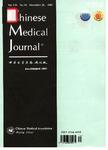5-Amino-4-oxopentanoic acid photodynamic diagnosis guided microsurgery and photodynamic therapy on VX2 brain tumour implanted in a rabbit model
5-Amino-4-oxopentanoic acid photodynamic diagnosis guided microsurgery and photodynamic therapy on VX2 brain tumour implanted in a rabbit model作者机构:Department of Neurosurgery Southwest Hospital Third Military Medical University Chongqing 400038 China Department of Radiology Southwest Hospital Third Military Medical University Chongqing 400038 China Department of Pathology Sichuan Provincial Cancer Hospital Chengdu Sichuan 610041 China Department of Ophthalmology Research Institute of Surgery Daping Hospital Third Military Medical University Chongqing 400042 China
出 版 物:《Chinese Medical Journal》 (中华医学杂志(英文版))
年 卷 期:2009年第122卷第11期
页 面:1316-1321页
核心收录:
学科分类:1002[医学-临床医学] 100210[医学-外科学(含:普外、骨外、泌尿外、胸心外、神外、整形、烧伤、野战外)] 10[医学]
基 金:National Natural Science Foundatin of China
主 题:VX2 tumour model 5-amino-4-oxopentanoic acid photodynamic diagnosis photodynamic therapy mean survival time
摘 要:Background Complete tumour resection is important for improving the prognosis of brain tumour patients. However, extensive resection remains controversial because the tumour margin is difficult to be distinguished from surrounding brain tissue. It has been established that 5-amino-4-0xopentanoic acid (5-aminolevulinic acid, ALA) can be used as a photodynamic diagnostic marker and a photosensitizer for photodynamic therapy in surgical treatment of brain tumours. We investigated the efficacy of ALA photodynamically guided microsurgery and photodynamic therapy on VX2 brain tumour implanted in a rabbit model. Methods Eighty New Zealand rabbits implanted with VX2 brain tumours were randomly assigned to five groups: control, conventional white light microsurgery, a photodynamic therapy group, a photodynamically guided microsurgery group and a group in which guided microsurgery was followed by photodynamic therapy. The VX2 tumour was resected under a surgical microscope. The tumour resection was confirmed with histological analysis. All animals were examined with MRI for presence of any residual tumour tissue. The survival time of each rabbit was recorded. Results All treatment groups showed a significantly extended survival time compared with the control group. Photodynamically guided microsurgery combined with photodynamic therapy significantly prolonged survival time, compared with guided microsurgery alone. MRI and the autopsy results confirmed removal of most of the tumours. Conclusions Our results suggest that photodynamically guided surgery and photodynamic therapy significantly reduce or delay local recurrence, increase the effectiveness of radical resection and prolong the survival time of tumour bearing rabbits. Their combination has the potential to be used as a rapid and highly effective treatment of metastatic brain tumours.



